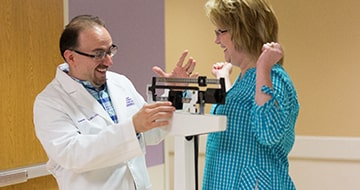Bariatric Surgery
Sign Up for a Bariatrics Informational Video
Also called a Roux-en-Y gastric bypass surgery This surgery reduces the amount of food you can eat at one time.
Gastric Sleeve is a type of weight loss surgery that removes up to two-thirds of the stomach. It’s also known as a...
Learn more about our weight loss procedures including surgical and non-surgical teatments.
Patient navigators are here to help our patients, their families and caregivers maneuver their healthcare journey and ov...
BMI Calculator
Body mass index (BMI) is a measure of body fat based on height and weight that applies to adult men and women.Enter the following information and calculate your BMI.
Underweight
Less than 18.5
Normal
18.5 to 24.9
Overweight
25 to 29.9
Obese
30 or greater
- Note: Results of the BMI calculator are based on averages.
- Privacy Assurance: Information that you enter will not be saved or sent to any website.
- Source: National Heart, Lung, and Blood Institute; National Institutes of Health; U.S.Department of Health and Human Services.
Are you a Candidate?
Location Results
for {{LookingWhereSearchResult}} within {{SelectedMiles}} miles
{{LocationsTitle}}
{{milesInfo(facility.distanceInMiles)}} miles
{{facility.Title}}
- {{facility.Address.Street}}
- {{facility.Street2}}
- {{facility.Address.City}}, {{facility.Address.StateCode}} {{facility.Address.Zip}}
- {{facility.Phone}}
{{milesInfo(facility.distanceInMiles)}} miles
{{facility.Title}}
- {{facility.Address.Street}}
- {{facility.Street2}}
- {{facility.Address.City}}, {{facility.Address.StateCode}} {{facility.Address.Zip}}
- {{facility.Phone}}
{{milesInfo(facility.distanceInMiles)}} miles
{{facility.Title}}
- {{facility.Address.Street}}
- {{facility.Street2}}
- {{facility.Address.City}}, {{facility.Address.StateCode}} {{facility.Address.Zip}}
- {{facility.Phone}}
{{facility.Title}}
{{facility.Address.Street}}, {{facility.Street2}}
{{facility.Address.City}}, {{facility.Address.StateCode}} {{facility.Address.Zip}}
Your search found no results. You may search again by adjusting your search criteria.








